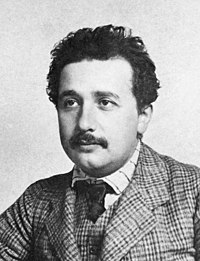
Back أوراق العام المعجزة Arabic অ্যানাস মিরাবিলিস গবেষণাপত্র Bengali/Bangla Articles de l'annus mirabilis Catalan Artículos del Annus mirabilis de Einstein Spanish مقالههای استثنائی اینشتین Persian Annus mirabilis d'Albert Einstein French שנת הפלאות (1905) HE Makalah annus mirabilis ID Annus Mirabilis Papers Italian アインシュタインの奇跡の年 Japanese

The annus mirabilis papers (from Latin annus mīrābilis, "miraculous year") are the four[a] that Albert Einstein published in the scientific journal Annalen der Physik (Annals of Physics) in 1905. As major contributions to the foundation of modern physics, these scientific publications were the ones for which he gained fame among physicists.[2] They revolutionized science's understanding of the fundamental concepts of space, time, mass, and energy. Because Einstein published all four of these papers in a single year, 1905 is called his annus mirabilis (miraculous year).
- The first paper explained the photoelectric effect, which established the energy of the light quanta , and was the only specific discovery mentioned in the citation awarding Einstein the 1921 Nobel Prize in Physics.[3]
- The second paper explained Brownian motion, which established the Einstein relation and compelled physicists to accept the existence of atoms.
- The third paper introduced Einstein's special theory of relativity, which proclaims the constancy of the speed of light and derives the Lorentz transformations. Einstein also examined relativistic aberration and the transverse Doppler effect.[4]
- The fourth, a consequence of special relativity, developed the principle of mass–energy equivalence, expressed in the equation and which led to the discovery and use of nuclear power decades later.
These four papers, together with quantum mechanics and Einstein's later general theory of relativity, are the foundation of modern physics.
- ^ Penrose, Roger (2005). "Foreward". Einstein's Miraculous Year: Five Papers That Changed the Face of Physics. By Einstein, Albert. Stachel, John (ed.). Princeton University Press. ISBN 9780691122281. Retrieved 5 January 2024.
- ^ Holton, Gerald (1960). "On the Origins of the Special Theory of Relativity". American Journal of Physics. 28 (627). doi:10.1119/1.1935922.
- ^ Nobel Foundation. "The Nobel Prize in Physics 1921". Retrieved 7 November 2020.
- ^ Shankland, Robert Sherwood (1964). "Michelson-Morley Experiment". American Journal of Physics. 32: 16–35. doi:10.1119/1.1970063.
Cite error: There are <ref group=lower-alpha> tags or {{efn}} templates on this page, but the references will not show without a {{reflist|group=lower-alpha}} template or {{notelist}} template (see the help page).



